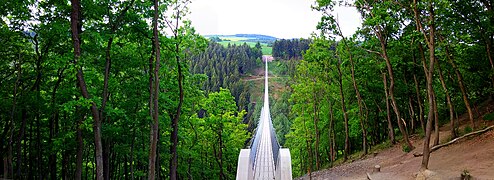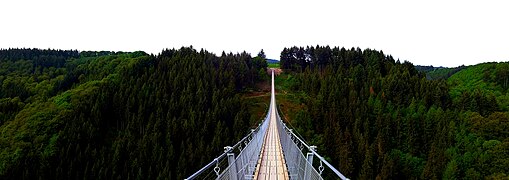Geierlay
Coordinates: 50 ° 5 ′ 24 ″ N , 7 ° 20 ′ 28 ″ E
| Geierlay | |
|---|---|
| Geierlay suspension bridge in its total length seen from the Mörsdorf side | |
| Official name | Geierlay suspension rope bridge |
| use | footbridge |
| Convicted | Geierlay Mörsdorf - Sosberg circular route |
| Subjugated | Mörsdorfer Bach |
| place | Mörsdorf |
| construction | Rope bridge |
| overall length | 360 m |
| width | 0.85 m running surface, 1.44 m rope railing (trapezoidal cross-section) |
| Longest span | 360 m |
| Construction height | 1.5 m (including rope railing) |
| Load capacity | 2.5 kN / m² |
| building-costs | 1,140,000 euros |
| start of building | May 26, 2015 |
| completion | September 30, 2015 |
| opening | 3rd October 2015 |
| planner | Stadt-Land-plus (planning), Hans Pfaffen (statics), crestageo ag (execution), both Chur |
| toll | no |
| Above sea level | 321 m above sea level NHN |
The suspension rope bridge Geierlay (official name), or Geierlay for short , is a pedestrian rope bridge between the local communities of Mörsdorf ( Rhein-Hunsrück district ) and Sosberg ( district of Cochem-Zell ). It is located in the Hunsrück and crosses the Mörsdorfer Bachtal . With a length of 360 m, it was considered the longest suspension bridge in Germany until the Titan RT was built on the Rappbode Dam in 2017.
history
The idea of a suspension bridge arose in Mörsdorf in 2006 when planning a village renewal , but was initially rejected as not feasible. Three citizens of the community, including the later mayor, picked up the idea again in 2010 and pushed the development forward. In the same year, the local council decided to implement it. Construction began at the end of May 2015, and the opening took place on October 3, 2015, as planned.
Idol
The bridge was constructed based on the Nepalese model, which is also the case with the Trift Bridge in the Urner Alps ( Switzerland ). The feasibility study, tourism concept, project coordination and construction management were carried out by the Boppard- based office for urban development and environmental planning Stadt-Land-plus . The planning, statics and execution of the bridge itself was carried out by Swiss companies from Chur .
technology
The bridge has a total length of 360 m and is one of the longest suspension bridges in Europe. The maximum height above the ground is almost 100 m. The dead weight is 62 tons.
The load-bearing structure consists of four lower, closed spiral ropes with a diameter of 40 mm and two open spiral ropes running at the top, which also serve as a handrail and are 32 mm thick. The suspension ropes were anchored for each abutment with six Dywidag anchor rods with a diameter of 63 mm, which were cemented into the rock up to 25 m deep.
Two parabolically mounted wind load ropes run diagonally below the lower load ropes, which are mounted in the rock with 9 m deep Geoflex anchors with a pretension of 100 kN. In contrast to rigid rod anchors, “flex heads” of rope anchors have a clearance of up to ± 30 ° to the drilling axis, so that the bending forces transmitted by the wind can be better balanced. The bridge is braced diagonally downwards on these ropes, which stabilizes it laterally so that it does not overturn in strong winds and generally shows a dampened vibration behavior.
The bridge carries a maximum load of 76.5 tons, which corresponds to around 950 people with an assumed average weight of 80 kg. ( Source? ) The actual rope bridge was built within four weeks in September 2015 after the abutments were completed.
The four wooden planks of the sidewalk (0.85 m wide, 6 cm thick), placed next to each other at a distance of 10 mm, are made of pressure-impregnated Douglas fir , which is permitted in Germany as construction timber for load-bearing structures, and were laid lengthways on the 1, 49 m of assembled steel T-beam screwed. The steel construction made of S355 steel was prefabricated by the steel construction company Mair Wilfried in St. Lorenzen (South Tyrol) on behalf of Crestageo and delivered to Mörsdorf ready for assembly. The distance between the handrail ropes allows an accessible space of 1.40 m at shoulder height. Therefore, the bridge can only be used by pedestrians, bicycles have to be pushed.
- Technical details of the bridge
T-beams as supports for the wooden planks
Touristic concept
The name of the bridge is taken from the field name of the district on which the bridge is located: A rocky slope called Geierslay, which probably got this name because numerous birds of prey live near the rock ( see also Ley ) . A falconry is a reminder of this historical fact. The word " vulture ", derived from the Middle High German "gir" as a noun of "greedy", is still a trivial term for a number of different species of birds of prey. The name Geierlay (without s ) was determined in a public naming competition.

The overall concept of Geierlay includes a visitor center with a large paid parking lot in Mörsdorf , also for coaches. There is a bistro in the visitor center . The bridge itself can only be reached on foot or by bike over 1.8 km of well-paved path.
The bridge crosses the Saar-Hunsrück-Steig between stage 19 and stage 20 and is part of the two Geierlay circular routes:
- The "big" Geierlay loop leads on an approximately 5.5 km long circular path from the Mörsdorf visitor center over the rope suspension bridge and on a section of the Saar-Hunsrück climb under the rope suspension bridge back to Mörsdorf.
- The "small" Geierlay loop with a length of about 3.6 km follows the shortcut from the Mörsdorf bridgehead over a meadow path and through a small piece of forest back to the visitor center.
The 2010 feasibility study assumes up to 170,000 guests annually on the bridge and up to 50,000 additional overnight stays. Additional income from local tourism of 2.5 million euros is also expected. Criticism comes from the Rhineland-Palatinate Court of Auditors : The goal of a sustainable increase in tourism is not achieved by setting up the suspension rope bridge.
The bridge can be crossed free of charge and is open all year round, except during storms and thunderstorms. In the first four weeks after it opened, it was visited by around 45,000 people. On December 30, 2015, the one hundred thousandth visitor was officially welcomed and after a year, camera analysis already counted over 370,000 visitors, of which around 20 percent only looked at the Geierlay without stepping on them.
financing
The bridge project has a total volume of 1.14 million euros. It was mainly through funds from the LEADER funding program of the European Union (460,000 euros) and the State of Rhineland-Palatinate funded (240,000 euros). Surrounding communities took part with 100,000 euros. a. the city of Kastellaun . The community of Mörsdorf bears the remaining costs of 350,000 euros. The annual maintenance costs are around 14,000 euros. According to Mayor Marcus Kirchhoff, income from the use of wind power in Mörsdorf made it possible to refinance these costs.
Web links
- geierlay.de - Official site
Individual evidence
- ↑ Jessica Kuschnik: The longest suspension bridge hangs in the Hunsrück. In: Rheinische Post. June 10, 2015, accessed January 27, 2020 .
- ↑ Andrea Lohmann: Suspension bridge almost finished - thrills at a height of 100 meters. (No longer available online.) In: SWR Landesschau Rheinland-Pfalz. September 25, 2015, archived from the original on September 25, 2015 ; accessed on January 28, 2020 .
- ↑ Gudrun Fünter: television reportage. (No longer available online.) In: SWR TV . September 25, 2015, archived from the original on September 26, 2015 ; accessed on January 28, 2020 (video, 3:07 min.).
- ↑ Detlef Stoller: Test of courage for engineers: Walk over the longest suspension bridge in Germany. In: ingenieur.de , July 21, 2017, accessed on January 27, 2020.
- ↑ Spiral rope anchor and FLEX head. (PDF; 856 kB) The smarter anchor gives way. Geobrugg , January 21, 2020, accessed on January 29, 2020 (brochure).
- ↑ Numbers about the bridge. In: geierlay.de , accessed on January 27, 2020.
- ↑ Chris Kitching: Must have a head for heights! Fearless holidaymakers are the first to cross Germany's longest rope suspension bridge… 300 FEET above a canyon floor. In: Daily Mail online. October 4, 2015, accessed January 27, 2020 .
- ↑ Examination of the funding of the suspension bridge over the Mörsdorfer Bachtal. (PDF; 560 kB) In: Ask the state. Rhineland-Palatinate Court of Auditors, August 5, 2015, accessed on January 29, 2020 .
- ↑ Griese: Geierlay suspension bridge is a complete success - over 45,000 visitors in just under three weeks. Ministry for the Environment, Energy, Food and Forests Rhineland-Palatinate , October 22, 2015, accessed on January 29, 2020 .
- ↑ Thomas Torkler: Joy in the Hunsrück: Geierlay Bridge is already filling the 100,000. (No longer available online.) In: Rhein-Zeitung. January 2, 2016, archived from the original on January 23, 2018 ; accessed on January 29, 2020 .
- ↑ Jens Albus: You have to go over this bridge. In: Spiegel online. November 7, 2016, accessed November 7, 2016 .
- ↑ Kirchhoff quoted in: Energy stories Mörsdorf: Wind power enriches the region with attraction. In: ABO Wind , accessed on January 27, 2020.









